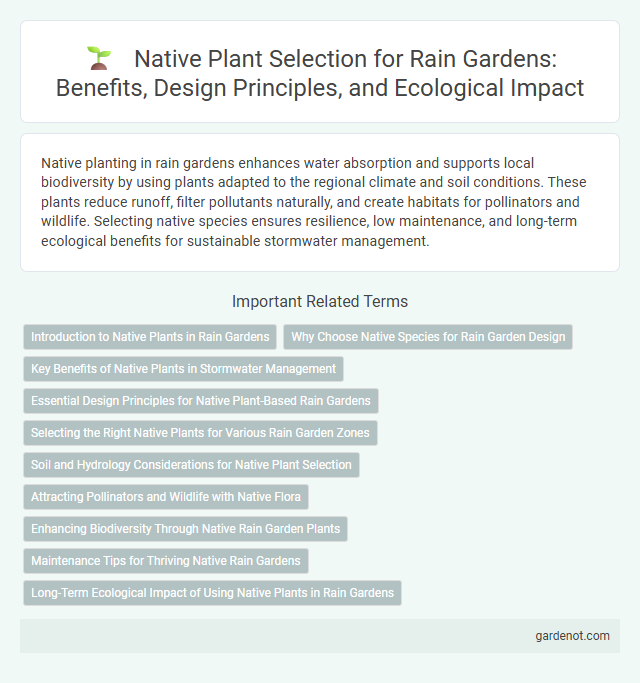Native planting in rain gardens enhances water absorption and supports local biodiversity by using plants adapted to the regional climate and soil conditions. These plants reduce runoff, filter pollutants naturally, and create habitats for pollinators and wildlife. Selecting native species ensures resilience, low maintenance, and long-term ecological benefits for sustainable stormwater management.
Introduction to Native Plants in Rain Gardens
Native plants in rain gardens enhance stormwater management by naturally filtering pollutants and improving soil absorption. Species such as purple coneflower (Echinacea purpurea), blue flag iris (Iris versicolor), and switchgrass (Panicum virgatum) are well-adapted to local climates, requiring less maintenance and supporting biodiversity. Incorporating native vegetation promotes resilient ecosystems, conserves water, and provides habitat for pollinators and wildlife.
Why Choose Native Species for Rain Garden Design
Native species in rain garden design enhance ecosystem resilience by supporting local wildlife and pollinators adapted to regional conditions. Their deep root systems improve soil permeability, effectively managing stormwater and reducing erosion. Choosing native plants ensures low maintenance requirements and greater sustainability by thriving naturally without excessive fertilizers or irrigation.
Key Benefits of Native Plants in Stormwater Management
Native plants in rain gardens enhance stormwater management by improving water infiltration and reducing runoff through their deep, fibrous root systems. These plants filter pollutants, such as heavy metals and sediments, improving water quality before it reaches waterways. Their adaptability to local climate and soil conditions ensures low maintenance and long-term sustainability in managing stormwater.
Essential Design Principles for Native Plant-Based Rain Gardens
Native plants in rain gardens enhance water absorption and support local biodiversity while requiring minimal maintenance. Essential design principles include selecting species adapted to local soil and moisture conditions, ensuring plant diversity to improve ecosystem resilience, and arranging plants based on their tolerance to wet and dry zones for optimal growth. Incorporating deep-rooted native species also stabilizes soil and reduces erosion, improving the garden's overall effectiveness in managing stormwater runoff.
Selecting the Right Native Plants for Various Rain Garden Zones
Selecting native plants for rain garden zones enhances water absorption and supports local ecosystems by matching plant species to specific microhabitats such as inundation zones, saturation zones, and upland edges. Inundation zones thrive with species like cardinal flower (Lobelia cardinalis) and swamp milkweed (Asclepias incarnata), which tolerate frequent water exposure, while saturation zones benefit from blue flag iris (Iris versicolor) and Joe-Pye weed (Eutrochium purpureum) that prefer moist but not constantly flooded soil. Upland edges are suited to dry-tolerant natives such as black-eyed Susan (Rudbeckia hirta) and butterfly weed (Asclepias tuberosa), ensuring diverse plant resilience and effective stormwater management.
Soil and Hydrology Considerations for Native Plant Selection
Selecting native plants for rain gardens requires careful assessment of soil type, drainage capacity, and hydrological patterns to ensure plant survival and effective water filtration. Soils with high clay content demand native species tolerant of slower drainage, while sandy soils support drought-resistant varieties that thrive under rapid water movement. Understanding seasonal water fluctuations and saturation periods guides the choice of native plants that stabilize soil and enhance rain garden function through efficient water absorption and pollutant removal.
Attracting Pollinators and Wildlife with Native Flora
Native planting in rain gardens supports local ecosystems by providing essential food and habitat for pollinators such as bees, butterflies, and hummingbirds. Choosing native flora like purple coneflower, milkweed, and goldenrod enhances biodiversity and encourages the presence of beneficial insects and birds. This sustainable approach improves pollination while maintaining resilience and adaptation to regional climate and soil conditions.
Enhancing Biodiversity Through Native Rain Garden Plants
Native rain garden plants enhance biodiversity by providing essential habitats and food sources for local wildlife, including pollinators like bees and butterflies. These plants are well-adapted to regional climates, promoting healthy soil ecosystems and supporting a variety of insect and bird species. Incorporating native species such as Echinacea, Asclepias, and Carex in rain gardens fosters ecological balance and resilience.
Maintenance Tips for Thriving Native Rain Gardens
Native planting in rain gardens promotes ecological balance by using species adapted to local soil and climate conditions, enhancing water absorption and pollutant filtration. Regular pruning and removal of invasive species prevent competition, ensuring healthy growth and optimal function of native plants. Seasonal mulching and monitoring soil moisture levels help maintain a stable environment, supporting native plants' resilience and long-term survival in rain gardens.
Long-Term Ecological Impact of Using Native Plants in Rain Gardens
Native plants in rain gardens enhance long-term ecological health by supporting local wildlife and promoting biodiversity. Their deep root systems improve soil structure and water infiltration, reducing runoff and erosion over time. Establishing native vegetation in rain gardens creates resilient ecosystems that require less maintenance and contribute to sustainable watershed management.
Native planting Infographic

 gardenot.com
gardenot.com